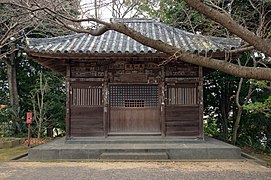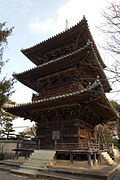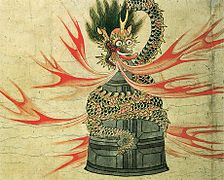Dōjō-ji
The Dōjō-ji ( Japanese 道 成 寺 ) is a temple in Hidakagawa ( 日 高 川村 ) in the district of Hidaka ( 日 高 郡 ), Wakayama Prefecture , which belongs to the Tendai class of Buddhism. It is the 5th temple on the New Saigoku Pilgrimage Route .
The Dōjō-ji is known from the old legend of Anchin ( 安 珍 ) and the princess Kiyo ( 清 姫 Kiyo hime ), who in literature, as Nō Dōjōji , as Bunraku , Kabuki and for the film, e.g. Kon Ichikawa's Musume no Dōjōji ( 1946) or Kihachirō Kawamoto's puppet animation film Dōjōji (1976), which has already been adapted several times.
history
According to temple tradition, the temple was built in the first year of Taihō (701) at the request of Emperor Mommu and wife Fujiwara no Miyako ( 夫人 藤原 宮 子 ) by Kinoōmi Michinari ( 紀大臣 道 成 ), whereupon the temple in Sino-Japanese reading by Michinari Dōjō -ji was called. According to excavations, the temple is dated to the beginning of the 9th century. At the end of the century, the temple became a large complex in the style of the time with a large south gate ( 南 大門 Nandaimon ), middle gate ( 中 門 Chūmon ), covered walkway (回廊 Kairō ), pagoda, main hall ( 金堂 Kondō ), teaching hall ( 講堂 Kōdō ), Abbot and monk quarters ( 僧房Sōbō ) and storage area ( 倉 院 Sōin ) flourished.
The temple later lost its importance, but in the 10th century it flourished again and as a Shingon temple it has preserved numerous Buddha images to the present day. In 1652, Grand Priest Tenkai ( 天 海 大 僧 正 Tenkai Daisōjō ) was able to enforce the adoption of the Tendai direction of Buddhism.
investment
One enters the temple from the south via a longer staircase through the temple gate ( 山門 Sanmon ; in Plan 1) from 1694, which is called Niō-Tor ( 仁王 門 Niō-mon ), i.e. as a gate with the two temple guards on the left and right from the passage. Ahead you can see the main hall ( 本 堂 Hondō ; 2). Both buildings are registered as an Important Cultural Property of Japan . The main hall was built in 1357 by the 3rd son of Yoshida Kurōdoyorihide ( 吉田 蔵 人 頼 秀 ), namely Minamoto Kompiramaru ( 源 金 毘羅 丸 ). The building has 8 columns in the front and 6 columns in the depth, has the shape of a modified hipped roof and is covered with tiles.
The three-story pagoda ( 三重 塔 Sanjū-no-tō ; 3) is the only one in the prefecture, it was built in 1763. Next to the pagoda, Anchin is said to be buried under the Anchin hill ( 安 珍 塚 Anchin-zuka ). The pagoda and the Abtresidenz within the Abt- and monk quarters (A), so the Shoin ( 書院 ) are registered as a cultural asset of the prefecture. Under the trees southeast of the pagoda is the Enma Pavilion ( 閻 魔 堂 ; 4) also known as the “Ten Kings Pavilion” ( 十 王 堂 Jūō-dō ).
In the northwest of the site you can find the Goma Pavilion ( 護 摩 堂 ; 5), the foundations of the bell tower ( 鐘楼 Shōrō ; 7) and a small Shintō shrine, the Chinju Sansha ( 鎮守 三 社 ; 6), hidden under a building . In the great hall in the southwest, in the Dōjōji-Engi-Hall ( 道 成 寺 縁 起 堂 ; 8), Anchin and Kiyohime are remembered.
Temple treasures
- It is registered as a national treasure
- a standing, thousand-armed wooden Kannon with two saints as companions ( 木造 千手 観 音 立 像 ・ 木造 菩薩 立 像 2 躯 Mokuzō Senju-Kannon ritsuzō - 2 Mokuzō bosatsu ritsuzō )
- The following sculptures are registered as important cultural assets of Japan:
- Bishamon-ten ( 木造 毘 沙門 天 立 像 Mokuzō Bishamonten ritsuzō ), on display in the Tokyo National Museum ,
- a standing 1000-armed cannon, wood covered with lacquer ( 木 心 乾 漆 千手 観 音 立 像 Mokushin kanshitsu senju Kannon ritsuzō ),
- a standing 1000-armed Kannon, ( 木造 千手 観 音 立 像 Mokuzō senju Kannon ritsuzō(鞘 仏 Sayabotoke ),
- Bishamon-ten (木造 毘 沙門 天 立 像 2 躯), one of which was entrusted to the Tokyo National Museum ,
- an eleven-faced Kannon made of wood ( 木造 十 一面 観 音 立 像 Mokuzō jūichimen Kannon ritsuzō ),
- the Four Kings of Heaven ( 木造 四天 王立 像 Mokuzō Shitennō ritsuzō )
- and the following manuscripts:
- History of the origins of the Dōjōji ( 紙 本 著色 道 成 寺 縁 起 絵 巻 Shihon chakushoku Dōjōji engi emaki ),
- Darani Sutra ( 色 紙墨 書 千手千眼 陀羅尼 経 Shokushi bokusho senjusengen darani-kyō ).
photos
literature
- Wakayama-ken kotogakko-shakai-ka kenkyu-kyokai (Ed.): Dojo-ji . In: Wakayama-ken no rekishi sampo. Yamakawa Shuppan, 2009. ISBN 978-4-634-24630-0 . P. 229.
Web links
Coordinates: 33 ° 54 '52.2 " N , 135 ° 10' 28.4" E








